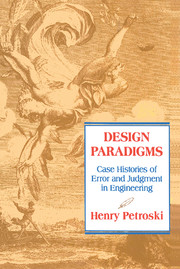Book contents
- Frontmatter
- Contents
- Preface
- 1 Introduction
- 2 Paconius and the Pedestal for Apollo
- 3 Vitruvius's Auger and Galileo's Bones: Paradigms of Limits to Size in Design
- 4 Galileo and the Marble Column
- 5 Galileo's Confirmation of a False Hypothesis
- 6 The Design and Collapse of the Dee Bridge
- 7 The Britannia Tubular Bridge
- 8 Failure as a Source of Engineering Judgment
- 9 The Design Climate for the Tacoma Narrows Bridge
- 10 Historic Bridge Failures and Caveats for Future Designs
- 11 Conclusion
- Bibliography
- Index
8 - Failure as a Source of Engineering Judgment
John Roebling as a Paradigmatic Designer
Published online by Cambridge University Press: 05 June 2012
- Frontmatter
- Contents
- Preface
- 1 Introduction
- 2 Paconius and the Pedestal for Apollo
- 3 Vitruvius's Auger and Galileo's Bones: Paradigms of Limits to Size in Design
- 4 Galileo and the Marble Column
- 5 Galileo's Confirmation of a False Hypothesis
- 6 The Design and Collapse of the Dee Bridge
- 7 The Britannia Tubular Bridge
- 8 Failure as a Source of Engineering Judgment
- 9 The Design Climate for the Tacoma Narrows Bridge
- 10 Historic Bridge Failures and Caveats for Future Designs
- 11 Conclusion
- Bibliography
- Index
Summary
The first and most indispensable design tool is judgment. It is engineering and design judgment that not only gets projects started in the right direction but also keeps a critical eye on their progress and execution. Engineering judgment, by whatever name it may be called, is what from the very beginning of a conceptual design identifies the key elements that go to make up an analytical or experimental model for exploration and development. It is judgment that separates the significant from the insignificant details, and it is judgment that catches analysis going astray. Engineering judgment is the quality factor among those countless quantities that have come to dominate design in our postcomputer age. Judgment tells the designer what to check on the back of an envelope and what to measure at the construction site. Judgment, in short, is what avoids mistakes, what catches errors, what detects flaws, and what anticipates and obviates failure. The single most important source of judgment lies in learning from one's mistakes and those of others.
All meaningful improvements in analytical and computational capabilities are at heart improvements in our ability to anticipate and predict failure. Every engineering calculation is really a failure calculation, for a calculated quantity has meaning for engineering only when it is compared with a value representing a design constraint or failure criterion of some kind.
- Type
- Chapter
- Information
- Design ParadigmsCase Histories of Error and Judgment in Engineering, pp. 121 - 143Publisher: Cambridge University PressPrint publication year: 1994
- 1
- Cited by



